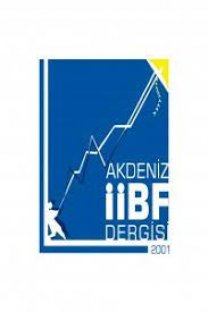Örgütsel Yapılarda Romantik İlişkiler: Algılanan Güdüler ve Davranış Değişiklikleri Üzerine Bir Araştırma
Bu çalışmanın amacı, çalışanların (gözlemcilerin) algılarına göre, işyerinde romantik ilişki yaşayan bireylerin işyeri romantizmine yönelmelerinde oluşturdukları güdü oluşumlarını ve davranış değişikliklerini belirlemektir. Araştırma sonucunda işyeri romantizmi içindeki taraflarda daha çok kayırmacılık davranışının görüldüğü, işyeri romantizmine kadınların aşk güdüsüyle, erkeklerin ise ego güdüsüyle yöneldiği tespit edilmiştir. Ayrıca, araştırmaya katılan gözlemcilerin daha önce işyeri romantizmi yaşamaları ile işyerinde yaşanan romantik ilişkileri onaylamaları arasında anlamlı bir ilişki bulunmamıştır.
Romantic Relationships in Organizational Settings: A Study on Perceived Motivations and Behavioral Changes
The aim of this study is to determine motivational formations and behavioral changes according to employee’s (observer’s) perceptions, which occur when individuals who have romantic relationship at workplace bear to workplace romance. As a result, it is observed that the favoritism is mostly seen between people who have romantic relationship, and women bear to workplace romance by love motive while men bear by ego motive. On the other hand, it is also found that there is no significant relation for observers between having workplace romance before and approving romantic relationships in the workplace.
___
- ANDERSON, C.J., FISHER, C., “Male-Female Relationships in the Workplace: Perceived Motivations in Office Romance”, Sex Roles, Vol.25, 1991:163-180.
- ANDERSON, C.L., HUNSAKER, P.L., “Why There is Romancing at the Office and Why It’s Everybody’s Problem”, Personnel, Vol.62-2, 1985:57-63.
- BROWN, T.J., ALLGEIER, E.R., “Manager’s Perceptions of Workplace Romances: An Interview Study”, Journal of Business and Psychology, Vol.10-2, 1995: 169-176.
- BROWN, T.J., ALLGEIER, E.R., “The Impact of Participant Characteristics, Perceived Motives, and Job Behaviors on Co-Workers' Evaluations of Workplace Romances”, Journal of Applied Social Psychology, Vol.26-7, 1996: 577-595.
- DEVINE, I., MARKIEWICZ, D., “Cross-Sex Relationships at work and the Impact of Gender Stereotypes”, Journal of Business Ethics, Vol.9, 1990:333-338.
- DILLARD, J.P., “Close Relationships at Work: Perceptions of the Motives and Performance of Relational Participants”, Journal of Social and Personal Relationships, Vol.4, 1987: 179-193.
- DILLARD, J.P., BROETZMANN, S.M., “Romantic Relationships at Work: Perceived Changes in Job-Related Behaviors as a Function of Participant’s Motive, Partner’s Motive, and Gender”, Journal of Applied Social Psychology, Vol.19-2, 1989: 93-110.
- DILLARD, J.P., HALE, J.L., SERGIN, C., “Close Relationships in Task Environments: Perceptions of Relational Types, Illicitness, and Power”, Management Communication Quarterly, Vol.7-3, 1994:227-255.
- DILLARD, J.P., MILLER, K., “Intimate Relationships in Task Environments”, Handbook of Personal Relationships, Newyork, Willey, 1988:449-465.
- FOLEY, S., POWELL, G.N., “Not All is Fair in Love and Work: Coworkers’ Preferences for and Responses to Managerial Interventions Regarding Workplace Romances”, Journal of Organizational Behavior, Vol.20-7, 1999: 1043-1056.
- JONES, G.E., “Hierarchical Workplace Romance: An Experimental Examination of Team Member Perceptions”, Journal of Organizational Behavior, Vol. 20-7, 1999: 1057-1072.
- KARL, K.A., SUTTON, C.L., “An Examination of the Perceived Fairness of Workplace Romance Policies”, Journal of Business and Psychology, Vol: 14-3, 2000: 429-442.
- MAINIERO, L., “A Review and Analysis of Power Dynamics in Organizational Romance”, Academy of Management Review, Vol.11-4, 1986: 750-762.
- PAUL, R.J., TOWNSEND, J.B., “Managing the Workplace Romance: Protecting Employee and Employer Rights”, Review of Business, Vol.19-2, 1998:25-30
- PIERCE, C.A., “Factors Associated With Participating in a Romantic Relationship in a Work Environment”, Journal of Applied Social Psychology, Vol. 28-18, 1998: 1712-1730.
- PIERCE, C.A., AGUINIS, H., “A Framework for Investigating The Link Between Workplace Romance and Sexual Harassment”, Group & Organization Management, Vol.26-2, 2001: 206-229.
- PIERCE, C.A., AGUINIS, H., “Romantic Relationships in Organizations: A Test of a Model of Formation and Impact Factors”, Management Research, Vol.1-2, 2003:161-169.
- PIERCE, C.A., AGUINIS, H., ADAMS, S.K.R, “Effects of a Dissolved Workplace Romance and Rater Characteristics on Responses to A Sexual Harassment Accusation”, Academy of Management Journal, Vol.43-5, 2000: 869-880.
- PIERCE, C.A., BROBERG, B.J., MCCLURE, J.R., AGUINIS, H., “Responding to Sexual Harassment Complaints: Effects of A Dissolved Workplace Romance on Decision-Making Standards”, Organizational Behavior and Human Decision Processes, Vol.95, 2004: 66-82.
- PIERCE, C.A., BYRNE, D. AGUINIS, H., “Attraction in Organizations: A Model of Workplace Romance”, Journal of Organizational Behavior, Vol.17-1, 1996: 5-32.
- POWELL, G.N., “Workplace Romances Between Senior-Level Executives and Lower-Level Employees: An Issue of Work Disruption and Gender”, Human Relations, Vol.54-11, 2001:1519-1544.
- POWELL, G.N., FOLEY, S., “Something to Talk About: Romantic Relationships in Organizational Settings”, Journal of Management, Vol: 24-3, 1998, 421-448.
- QUINN, R., “Coping with Cupid: The Formation, Impact, and Management of Romantic Relationships in Organizations”, Administrative Science Quarterly, Vol.22, 1977:30- 45
- QUINN, R., LEES, P.L., “Attraction and Harassment: Dynamics of Sexual Politics in the Workplace”, Organizational Dynamics, Vol.13-1, 1984:35-46.
- SCHAEFER, C.M., TUDOR, T.R., “Managing Workplace Romances”, Advanced Management Journal, Vol.66-3, 2001: 4-10.
- SOLMUŞ, T. (2004) İş Yaşamında Duygular ve Kişilerarası İlişkiler, Beta Basım Yayım Dağıtım A.Ş., İstanbul.
- WESTHOFF, L.A., “What To Do About Corporate Romance”, Management Review, 1986:50-55.
- ISSN: 1302-9975
- Yayın Aralığı: Yılda 2 Sayı
- Başlangıç: 2001
- Yayıncı: Akdeniz Üniversitesi
